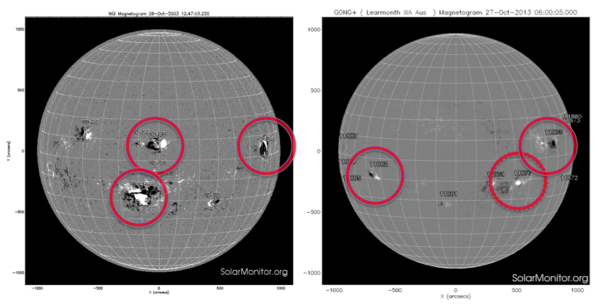The Halloween Flares and Large-Scale Correlations
From RHESSI Wiki
| Nugget | |
|---|---|
| Number: | 211 |
| 1st Author: | Richard Schwartz |
| 2nd Author: | Hugh Hudson |
| Published: | October 28, 2013 |
| Next Nugget: | Hard X-ray Footpoint Asymmetry |
| Previous Nugget: | Scattering Polarization in Solar Flares |
| List all | |
Contents |
Introduction
The celebrated phenomena of the "Halloween Flares" of 2003 have just reappeared, though more weakly, in October 2013. In the waning phase of the previous sunspot maximum, a remarkable group of apparently independent sunspot groups appeared within a few days of one another. Something like this has just happened, or is just happening, in the declining phase of our current sunspot maximum ([Cycle 24]). For reasons unknown in detail, and probably unknowable any time soon, the organization of solar activity visible at the surface has large-scale correlations in space and time, meaning that flares bunch up in a highly non-random manner:
October flares Year Class M Class X MX regions 2003 37 7 5 2013 32 4 6
From this little table one can see that the 2003 case had an even more extraordinary concentration of major flares in a small (but multiple) number of active regions.
Time scales and Correlations
In our conventional view of the sources of flare energy, we turn to the magnetic field in the corona. But it is the low corona, in active regions, that contains the bulk of the energy, and this appears above the photosphere only when flux emerges from the interior. Now we need to consider characteristic scales of space and time on the Sun. In the photosphere, the convective motions are organized into granulation and supergranulation, the latter also the source of the chromospheric network. The time/distance scales for these features are roughly 10 min/1000 km and 1 day/30,000 km respectively.
Now consider the occurrence pattern of the Halloween flares of 2003 and 2013, as illustrated in Figure 1. The major flares occur in each case on spatial and temporal scales quite inconsistent with what we see in the photosphere. Therefore it seems likely that some slowly-developing, large-scale structure in the deep interior - the legendary solar dynamo process - must be responsible.

These flaring patterns suggest that clues to the nature of the dynamo could come from an assessment of its time/space structure as an eigenmode problem, based on patterns like these. This had been suggested in Ref. [1], but so far as we're aware there is no parallel work on the flare distributions. Note that the organization of the coordinated eruptions crosses the equator in both cases (2003 and 2013). Patterns of coherence have also been remarked upon in terms of Svalgaard's "Hale sector" pattern; were the Halloween flares - though in both hemispheres in each October - within the same sector?
The October flares themselves are shown here as GOES records in Figure 2. The dashed line shows the X-flare threshold. Note that appearances on a logarithmic plot can be a bit misleading; the mean flux level in 2003 was a factor of 4-5 higher than in 2013..

Conclusions
We have pointed out another feature of the large-scale organization of the solar magnetic field, namely the intense energy it transports and delivers to solar flares. These have extremely short time scales, and yet they occur in structured patterns across space and time, something known since the sunspot cycle and butterfly diagram were first recognized (see also a Yohkoh Science Nugget on a related topic.
Note added Nov. 9, 2013: at Guigue's suggestion (G. Gimenez de Castro) we have extended Fig. 2 to include the data through the end of the 2003 Halloween "superevent". During the one-month period shown, the mean GOES 1-8 A flux was about a factor of 5 higher in 2003, but activity is still going strong in 2013.
References
[1] "Global Wave Patterns in the Sun's Magnetic Field"
| RHESSI Nugget Date | 28 October 2013 + |
| RHESSI Nugget First Author | Richard Schwartz + |
| RHESSI Nugget Index | 211 + |
| RHESSI Nugget Second Author | Hugh Hudson + |